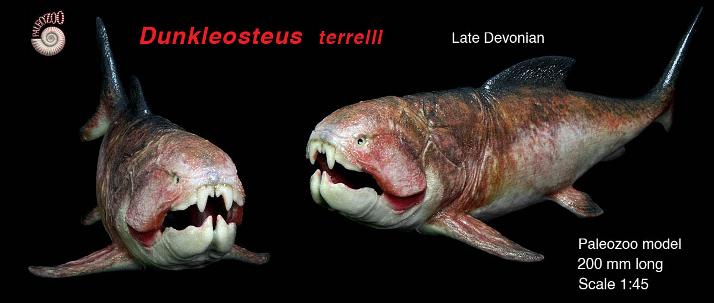Dunkleosteus terrelli is an extinct arthrodire placoderm from the Late Devonian period ( ~ 370 Mya). The apex predator of its time Dunkleosteus grew up to 9 metres in length and was possibly the largest of all creatures that existed during the Devonian Age of Fishes.
Discovered in 1867 by Jay Terrell Dunkleosteus terrelli is the largest of ten known species of the genus Dunkleosteus and was initially named Dinicthys - meaning "terrible fish". Since that time Dunkleosteus has become one of the most famous and emblematic organisms of the Palaeozoic era and yet surprisingly little is known about its overall morphology.
This is because almost all of the discovered remains are of dis-articulated bony segments from the forward skull section - to date no parts of the larger body have been unearthed aside from a small anterior section of pectoral fin. Early reconstructions therefore relied upon comparisons with other related species such as the placoderm Coccosteus. More recent analysis however is suggesting a different morphology.
The preponderance of dis-articulated remains has now been interpreted as meaning that Dunkleosteus lived in open waters (pelagic) and was probably a highly mobile swimmer (nektonic) - in contrast to other more bottom dwelling (benthic) placoderms such as Coccosteus. (Carr, 2010). So when a Dunkleosteus died it would have tended to bloat and float and then be dismembered by other organisms rather than being buried in place. Consequently only dis-articulated pieces of bony plate descended down through a deep water column to become buried within anoxic silts.
Building on the analysis that Dunkleosteus was a pelagic predator it is now thought to have had a similar morphology to other large hunting creatures in similar environments - such as modern day White Sharks. Comparative morphology now suggests a wider caudal fin, with a pronounced ventral lobe and a narrow peduncle. (Ferron et al, 2017). This would have enabled Dunkleosteus to be a very powerful and fast swimmer. This revised reconstruction well illustrates convergent evolutionary theory - whereby distantly related species can, within similar environments, evolve similar morphologies.
Dunkleosteus is a member of the order Arthrodira - meaning "jointed neck". This anatomical feature allowed the armoured skull to pivot upwards around a cranio-thoracic joint producing an extra wide gape. This, in conjunction with a powerful jaw configuration, meant that Dunkleosteus was capable of biting down with enormous pressure (Anderson, 2007). Studies also suggest that Dunkleosteus would have been able to open its mouth extremely quickly - creating a partial vacuum that helped suck prey into the mouth.
Dunkleosteus didn’t have teeth but rather two interlocking bony plates that self-sharpened as the jaws opened and shut. These plates would have easily crushed through the armour of even the biggest arthropods that lived during this period. Dunkleosteus would have been a formidable predator.








